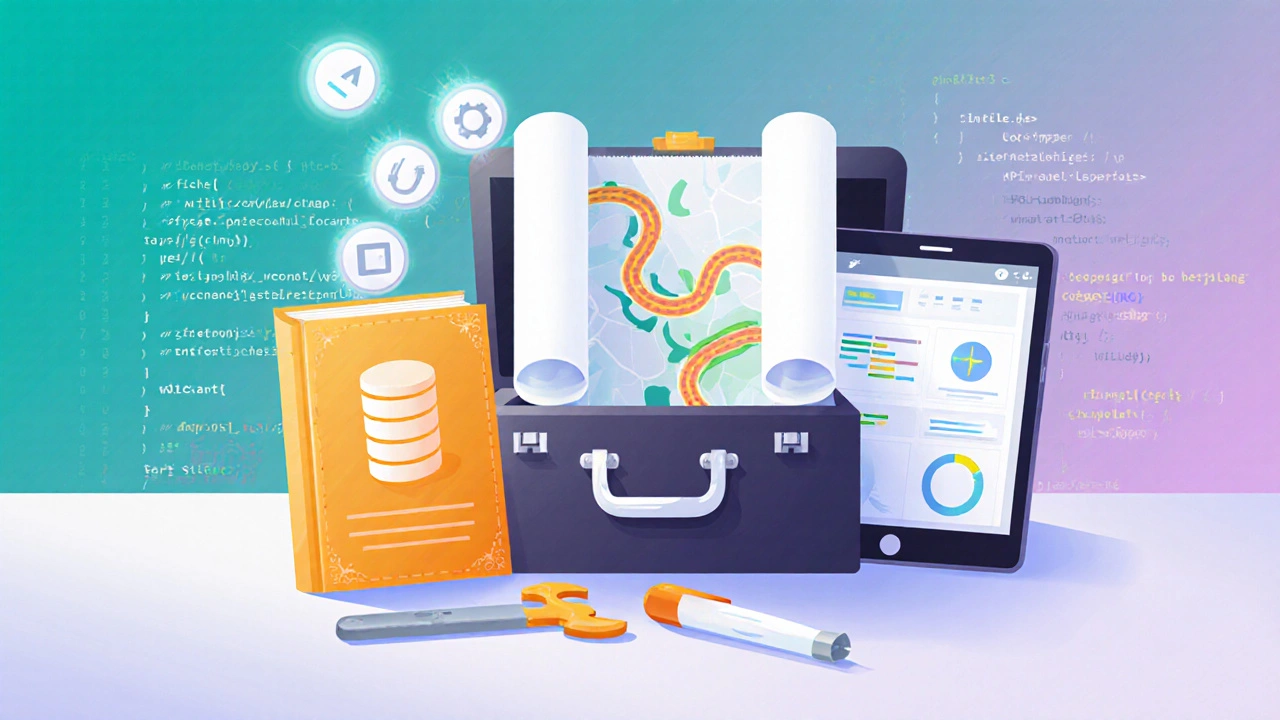Web Framework Selection Tool
Choose your project requirements
Select all features you need for your project to determine which framework is best suited for your needs.
Required Features
Project Characteristics
Your Recommendation
Django is a high‑level Python web framework that encourages rapid development and clean, pragmatic design. It was released in 2005, and since then it has powered sites like Instagram, Pinterest, and the Washington Post. While many newcomers hear "Django" and immediately think of Python, the two are not interchangeable. In this article we’ll peel back the layers, explore what each brings to the table, and answer the core question: is Django just Python?
Key Takeaways
- Django is a full‑stack web framework built on top of the Python language.
- Python provides the core syntax, data structures, and runtime; Django adds routing, ORM, templating, and admin interfaces.
- Choosing Django over a plain Python script makes sense for complex, data‑driven sites.
- For tiny APIs or micro‑services, lighter tools like Flask may be more appropriate.
What Is Python?
Python is an interpreted, high‑level programming language known for its readability and extensive standard library. Created by Guido van Rossum in 1991, it has become the go‑to language for everything from web development to data science.
Python’s design philosophy emphasizes "one obvious way to do it," which makes it easy for beginners to pick up and for seasoned developers to stay productive. Its dynamic typing, built‑in data structures like lists and dictionaries, and a massive ecosystem of third‑party packages give it flexibility across domains.
Enter Django: A Framework, Not a Language
Django takes the Python language and extends it with a set of conventions and tools that make building web applications faster and more maintainable. Think of Python as the engine and Django as the chassis, steering system, and dashboard all rolled into one.
If you’re deciding whether Django is right for your project, start by understanding its scope. Django ships with an Object‑Relational Mapper (ORM), a robust URL routing system, a templating engine, and an automatically generated admin panel-all ready to use out of the box.
Core Components of Django
- ORM is an Object‑Relational Mapper that translates Python classes into database tables and vice‑versa. It abstracts SQL away, letting you write Python code to query, insert, and update data.
- URL Dispatcher - maps clean URLs to view functions or class‑based views.
- Template Engine - renders HTML using a simple syntax ({{ variable }}).
- Form System - handles validation, rendering, and processing of user input.
- Django admin is an automatically generated administrative interface for managing site data. It requires almost no configuration.
- Middleware - hooks that process requests/responses globally.
All these pieces are tightly integrated, following the Model‑View‑Controller (MVC) pattern-though Django calls its layers Model‑Template‑View (MTV). The pattern encourages separation of concerns, making code easier to test and scale.
MVC is a software architectural pattern that separates data (Model), UI (View), and business logic (Controller). Django’s implementation mirrors this philosophy but renames the components to fit web terminology.

How Django Leverages WSGI
Behind the scenes, Django talks to the web server using the Web Server Gateway Interface (WSGI). This standard interface lets Python applications run on any WSGI‑compatible server like Gunicorn or uWSGI.
WSGI is a specification that defines a simple and universal interface between web servers and Python web applications. By adhering to WSGI, Django can be deployed on a wide range of platforms without changing the core code.
Django vs. Writing Plain Python Scripts
To illustrate the difference, let’s look at a tiny “Hello, World!” example.
# Plain Python using the built‑in HTTP server (Python 3.11)
import http.server, socketserver
class Handler(http.server.SimpleHTTPRequestHandler):
def do_GET(self):
self.send_response(200)
self.end_headers()
self.wfile.write(b"Hello, World!")
with socketserver.TCPServer(("", 8000), Handler) as httpd:
print("Serving at port 8000")
httpd.serve_forever()
This works for a single endpoint, but scaling it up quickly becomes messy-each new route, form, or database query adds repetitive boilerplate.
Now the same functionality in Django:
# mysite/urls.py
from django.urls import path
from . import views
urlpatterns = [
path('', views.home),
]
# mysite/views.py
from django.http import HttpResponse
def home(request):
return HttpResponse("Hello, World!")
Even though the example is simple, you instantly get access to Django’s settings, middleware, and admin interface. Adding a database model later only requires defining a class and running migrations-no raw SQL needed.
Comparison: Django vs. Flask
| Aspect | Django | Flask |
|---|---|---|
| Philosophy | "Batteries‑included" - provides ORM, admin, auth, etc. | Micro‑framework - adds extensions as needed. |
| Learning curve | Steeper due to many built‑in components. | Gentle; easier for tiny services. |
| ORM | Integrated Django ORM | Optional (SQLAlchemy, Peewee, etc.) |
| Admin interface | Auto‑generated admin out of the box. | None; third‑party extensions required. |
| Scalability | Designed for large, complex sites. | Great for micro‑services and APIs. |
| Community & Docs | Extensive official docs, large ecosystem. | Active community, but smaller official docs. |
The table shows that Django isn’t merely Python code; it bundles a suite of tools that would otherwise require multiple third‑party packages when using plain Python or Flask.
When to Choose Django Over Plain Python
Use Django when you need any of the following:
- Complex data models with relational databases.
- User authentication, permissions, and groups.
- An admin dashboard for content editors.
- Reusable apps that can be plugged into multiple projects.
- SEO‑friendly URLs and built‑in security features (CSRF protection, XSS mitigation).
If you’re building a quick script, a data‑processing pipeline, or a single‑function API, raw Python or a minimalist framework like Flask will be faster to spin up and easier to maintain.

Common Misconceptions
- Misconception: "Django is just another name for Python."
Reality: Django is a separate, high‑level framework that runs on Python. You still write Python code, but Django adds a structured way to handle web‑related tasks. - Misconception: "You can replace Django with a few Python libraries."
Reality: You could assemble Flask, SQLAlchemy, Jinja2, and a custom admin, but you’d be reinventing what Django already ships with, losing the tight integration and convention‑over‑configuration benefits. - Misconception: "Django makes Python unnecessary for web work."
Reality: Django relies on Python’s runtime, standard library, and ecosystem. Without Python, Django can’t exist.
Getting Started Quickly
- Install Python (3.11 or newer) from python.org.
- Create a virtual environment:
python -m venv env && source env/bin/activate. - Install Django:
pip install django. - Start a new project:
django-admin startproject mysite. - Run the development server:
python manage.py runserver. - Visit
http://127.0.0.1:8000/to see the default welcome page.
From here you can generate an app (python manage.py startapp blog), define models, and let the built‑in admin handle content without writing any HTML.
Final Thoughts
Django is far more than a Python script-it’s a cohesive ecosystem that accelerates web development while still letting you write pure Python when you need to. Understanding the distinction helps you pick the right tool for your next project, avoid over‑engineering, and leverage the strengths of both Python and Django.
Frequently Asked Questions
Is Django a programming language?
No. Django is a web framework written in Python. You still write Python code when using Django.
Can I use Django without knowing Python?
You need basic Python knowledge because all Django code is Python. However, you don’t need to master the entire language before getting started.
When should I choose plain Python over Django?
If you’re building a small script, a command‑line tool, or a lightweight API where the overhead of a full framework isn’t justified, plain Python (or a micro‑framework) is a better fit.
How does Django’s ORM differ from raw SQL?
The ORM lets you define Python classes that map to database tables, allowing you to create, read, update, and delete records using Python code instead of writing SQL strings.
Is Django suitable for real‑time applications?
For heavy real‑time needs, you might pair Django with channels (WebSockets) or use an async framework like FastAPI. Django can handle moderate real‑time features but isn’t specialized for high‑throughput websockets.


